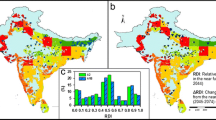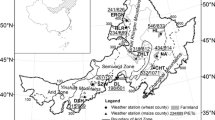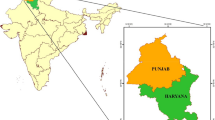Abstract
Water is essential for growing food and in some areas without irrigation agricultural production would not possible. Crop specific agricultural drought assessment requires integrated information on meteorological parameters, soil characters and plant vegetative dynamics throughout the growing season. Meteorological, Crop Growth Simulation Model and Space based approaches have their own inherent limitations. The main objective of this study is to examine the possibility of developing a rationally integrated drought assessment indicator for rice–wheat productivity over Indo-Gangetic Plains in India (IGP-India). Rice(Oryza sativa)–Wheat(Triticum aestivum) (RW) system is the major cropping system of the IGP-India and occupies 10 million hectares and provides food security and livelihoods to the people of this region. There are four major reasons for droughts in IGP-delay in the onset of monsoon/ failure of monsoon, variability of monsoon rainfall, long break in monsoon and areal difference in the persistence of monsoon. The Rational Integrated Drought Assessment Index (RIDAI) developed here explains 72% variations in rice productivity while it explains 94% variations of wheat productivity. Thus, this combined drought index tool captures all the drought years in the selected study area and this tool can be useful for getting preliminary assessment of drought impact, so that the researchers and planners can use this integrated tool for their decisions.
Similar content being viewed by others
References
Abramowitz M, Stegun IA (1972) Handbook of mathematical functions with formulas, graphs, and mathematical tables. Wiley, New York
Abrol IP, Bronson KF, Duxbury JM, Gupta RK (2000) Long-term soil fertility experiments in rice–wheat cropping systems. Rice–Wheat Consortium Research Series 6, New Delhi
Adams RM, Flemming RA, Chang CC, Mc Carl BA, Rosenzweig C (1995) A reassessment of the economic effects of global climate change on US agriculture. Clim Change 30:147–167
Aggarwal PK (2003) Impact of climate change on Indian Agriculture. J Plant Biol 30:189–198
Aggarwal PK, Kropff MJ, Cassman KG, ten Berge HFM (1997) Simulating genotypic strategies for increasing rice yield potential in irrigated, tropical environments. Field Crop Res 51:5–18
Aggarwal PK, Talukdar KK, Mall RK (2000a) Potential yields of the rice–wheat system in the Indo-Gangetic Plains of India. Rice–Wheat Consortium Paper Series 10. Rice–Wheat Consortium for the Indo-Gangetic Plain, New Delhi and Indian Agricultural Research Institute, New Delhi, India
Aggarwal PK, Bandyopadhyay SK, Pathak H, Kalra N, Chander S, Sujith Kumar S (2000b) Analyses of yield trends of the rice–wheat system in north-western India. Outlook Agric 29:259–268
Aggarwal PK, Joshi PK, Ingram JS, Gupta RK (2004) Adapting food systems of the Indo-Gangetic Plains to global environmental change: key information needs to improve policy formulation. Environ Sci Policy 7:487–498
Alexandrov VA, Hoogenboom G (2000a) The impact of climatic variability and change on crop yield in Bulgaria. Agric For Meteorol 104(4):315–327
Alexandrov VA, Hoogenboom G (2000b) Vulnerability and adaptation assessments of agricultural crops under climate change in the Southeastern USA. Theor Appl Climatol 67:45–63
Ansari H (2003) Monitoring and zoning of drought using fuzzy logic and GIS. PhD dissertation, Tarbiat Modarres University
Berge ten HFM, Aggarwal PK, Kropff MJ (1997) Applications of rice modeling. Elsevier, Netherlands
Bhalme HN, Mooley DA (1979) On the performance of modified Palmer index. In: Proceedings of international symposium: hydrological aspects of droughts
Bhandari AL, Ladha JK, Pathak H, Padre AT, Dawe D, Gupta RK (2002) Trends of yield and soil nutrient status in a long-term rice–wheat experiment in the Indo-Gangetic Plains of India. Soil Sci Soc Am J 66:162–170
Brown JF, Reed CB, Hayes MJ, Wilhie DA, Hubbard K (2002) A prototype drought monitoring system integrating climate and satellite data. In: Pecora 15/land satellite information IV/ISPRS commission I/FIEOS conference proceedings
Chipanshi AC, Ripley EA, Lawford RG (1997) Early prediction of spring wheat yields in Saskatchewan from current and historical weather data using the CERES-Wheat model. Agric For Meteorol 84:223–232
Dadhwal VK (1999) Remote Sensing and GIS in agricultural crop acreage and yield estimation. Int Arch Photogramm Remote Sens Spat Inf Sci 32(7-W9):58–67
Dadhwal VK (2003) Crop growth and productivity monitoring and simulation using remote sensing and GIS. Satellite remote sensing and GIS applications in Agriculture. In: Sivakumar, MVK, Roy PS, Harmsen K, Saha SK (eds) Proceedings of a training workshop held 7–11 July 2003 in Dehra Dun, India. AGM-8, WMO/TD No. 1182:263–289
Dadhwal VK, Sehgal VK, Singh RP, Rajak DR (2003) Wheat yield modeling using satellite remote sensing with weather data: recent Indian experience. Mausam 54(1):253–262
Delecolle R, Mass SJ, Guerif M, Baret F (1992). Remote sensing and crop production models: present trends. Int Arch Photogramm Remote Sens Spat Inf Sci 47:145–161
Duxbury JM, Abrol IP, Gupta RK, Bronson K (2000) Analysis of long-term soil fertility experiments with rice–wheat rotation in South Asia. In: Abrol IP, Bronson K, Duxbury JM, Gupta RK (eds) Long-term soil fertility experiments in rice–wheat cropping systems. Rice Wheat Consortium Research Series 6. Rice–Wheat Consortium for the Indo-Gangetic Plains, New Delhi, pp 7–22
Edossa DC, Babel MS, Gupta AD (2010) Drought analysis in the Awash River Basin, Ethiopia. Water Resour Manage 24:1441–1460
Edwards DC, McKee TB (1997) Characteristics of 20th century drought in the United States at multiple timescales. Colorado State University: Fort Collins. Climatology Report No. 92-7
Gibbs WJ, Maher JV (1967) Rainfall deciles as drought indicators, bureau of meteorology bulletin no. 48. Commonwealth of Australia, Melbourne, 29
Gijsman AJ, Hoogenboom G, Parton WJ, Kerridge PC (2002) Modifying DSSAT for low-input agricultural systems, using a soil organic matter-residue module from CENTURY. Agron J 94(3):462–474
Goswami BN, Venugopal V, Sengupta D, Madhusoodanan MS, Xavier PK (2006) Increasing trend of extreme rain events over India in a warming environment. Science 314:1442–1444
Hobbs PR, Morris ML (1996) Meeting South Asia’s future food requirements from rice–wheat cropping systems: priority issues facing researchers in the post Green Revolution era. NRG Paper 96-01. Mexico: CIMMYT
International governmental panel on climate change (2007) Summary for policymakers. Climate change 2007: the physical science basis. Contribution of Working Group I to the Fourth Assessment Report of the Intergovernmental Panel on Climate Change. Cambridge University Press, Cambridge, United Kingdom and New York, NY, USA
Jagtap SS, Mornu M, Kang BT (1993) Simulation of growth, development and yield of maize in the transition zone of Nigeria. Agric Syst 41:215–229
Jones JW, Hoogenboom G, Porter CH, Boote KJ, Batchelor WD, Hunt LA, Wilkens PW, Singh U, Gijsman AJ, Ritchie JT (2003) The DSSAT cropping system model. Eur J Agron 18:235–265
Kropff MJ, Teng PS, Aggarwal PK, Bouman BAM, van Laar HH (1996) Applications of systems approaches at the field level. Kluwer Academic, Netherlands
Ladha JK, Dawe D, Pathak H, Padre AT, Yadav RL, Singh B, Singh Y, Singh P, Kundu AL, Sakal R, Ram N, Regmi AP, Gami SK, Bhandari AL, Amin R, Yadav CR, Bhattarai EM, Gupta RK, Hobbs PR (2003a) How extensive are yield declines in long-term rice–wheat experiments in Asia? Field Crops Res 81:159–180
Ladha JK, Pathak H, Tirol-Padre A, Dawe D, Gupta RK (2003b) Productivity trends in intensive rice wheat cropping systems in Asia. In: Ladha, JK, Hill JE, Duxbury JM, Gupta RK, Buresh RJ (eds) Improving the productivity and sustainability of rice–wheat systems: issues and impacts. ASA Spec Publ 65:45–76
Lal H, Hoogenboom G, Calixte JP, Jones JW, Beinroth FH (1993) Using crop simulation models and GIS for regional productivity analysis. Trans ASAE 36:175–184
Lei Y, Tang T, Zheng L (2008) RS-CGM a spatial crop growth model based on GIS and RS. In: Proceedings SPIE, T104
Mandal C, Mandal DK, Srinivas CV, Sehgal J, Velayutham M (1999) Soil-climatic database for crop planning in India. NBSS Publ.53, NBSS&LUP, Nagpur
Mass SJ (1988a) Use of remotely sensed information in agricultural crop growth models. Ecol Model 41:247–268
Mass SJ (1988b) Using satellite data to improve model estimates of crop yield. Agron J 80:655–662
Matthews RB, Stephens W (2002) Crop–soil simulation models. Applications in developing countries. CABI Publishing, Oxford
Matthews RB, Kropff MJ, Bachelet D, van Laar HH (1995) Modeling the impact of climate change on rice production in Asia. CABI, Wallingford, UK and IRRI, Philippines
McKee TB, Doesken N, Kleist J (1993) The relationship of drought frequency and duration to time scales. In: Proceeding of the 8th conference on applied climatology. American Meteorological Society
McKee TB, Doesken NJ, Kleist J (1995) Drought monitoring with multiple time scales. In: Ninth conference on applied climatology. American Meteorological Society, Dallas
Morid S, Smakhtin V, Moghaddasi M (2006) Comparison of seven meteorological indices for drought monitoring in Iran. Int J Climatol 26:971–985
Moulin S, Bondeau A, Delecolle R (1998) Combining agricultural crop models and satellite observations: from field to regional scales. Int J Remote Sens 9(6):1021–1036
Nain AS, Vyas SP, Dadhwal VK, Singh TP (2001) Farm level wheat yield prediction using remote sensing data. In: Proc. ISRS National Symposium on Advances in Remote Sensing Technology with Special Emphasis on High Resolution Imagery, held at Space Applications Centre, Ahmedabad, from Dec. 11–13
Nain AS, Kersebaum KC, Mirschel W (2005) Are meteorological parameters based drought indices enough for agricultural drought monitoring: a comparative study of drought monitoring with SPI and Crop Simulation Model. In: ICID 21st European Regional Conference 2005, 15–19th May 2005, Frankfurt and Slubice—Germany and Poland
Nalbantis I, Tsakiris G (2009) Assessment of hydrological drought revisited. Water Resour Manage 23:881–897
NATCOM (2004) India’s initial national communication to the United Nations framework convention on climate change. National Communication Project, Ministry of Environment and Forests, Govt. of India
Nguyen VTV, In-na N, Bobee B (1989) New plotting position formula for Pearson type III distribution. J Hydraul Eng 115(6):706–730
Ntale HK, Gan TY (2003) Drought indices and their application to East Africa. Int J Climatol 23:1335–1357
Oza SR, Parihar JS, Dadhwal K (2002) Evaluating use of Standardized index for drought assessment in the region of North-west India. TROPMET-2002, 11–12 Feb., Bhubaneswar, India
Palmer WC (1965) Meteorological drought. Research Paper No. 45, U.S. Department of Commerce, Weather Bureau, Washington DC
Pandey RP, Pandey A, Galkate RV, Byun H, Mal BC (2010) Integrating Hydro-meteorological and physiographic factors for assessment of vulnerability to Drought. Water Resour Manage 24:4199–4217
Pashiardis S, Michaelides S (2008) Implementation of the Standardized Precipitation Index (SPI) and the Reconnaissance Drought Index (RDI) for regional drought assessment: a case study for Cyprus. Eur Water 23/24:57–65
Patel NR, Chopra R, Dadhwal VK (2007) Analysing spatial patterns of meteorological drought using standardized precipitation index. Int J Climatol 14(4):329–336
Pathak H, Bhatia A, Jain MC, Kumar S, Singh S, Kumar U (2002) Emission of nitrous oxide from soil in rice–wheat systems of Indo-Gangetic Plains of India. J Environ Monit Assess 77(2):163–178
Pathak H, Ladha JK, Aggarwal PK, Peng S, Das S, Singh Y, Singh B, Kamra SK, Mishra B, Sastri ASRAS, Aggarwal HP, Das DK, Gupta RK (2003) Climatic potential and on-farm yield trends of rice and wheat in the Indo-Gangetic Plains. Field Crops Res 80(3):223–234
Pathak H, Timsina J, Humphreys E, Godwin DC, Bijay-Singh, Shukla AK, Singh, U, Matthews RB (2004) Simulation of rice crop performance and water and N dynamics, and methane emissions for rice in northwest India using CERES Rice model. CSIRO Land and Water Technical Report 23/04. CSIRO Land and Water, Griffith, NSW 2680, Australia
Paulo AA, Pereira LS (2007) Prediction of SPI drought class transitions using Markov chains. Water Resour Manage 21(10):1813–1827
Penning de Vries FWT (1993) Rice production and climate change. In: Penning de Vries FWT (ed) Systems approaches for agricultural development. Kluwer Academic, Dordrecht
Porter JR, Jamieson PD, Wilson DR (1993) Comparison of the wheat simulation models AFRCWHEAT2, CERES-Wheat and SWHEAT for non-limiting conditions of crop growth. Field Crops Res 33:131–157
Rastogi A, Kalra N, Aggarwal PK, Sharma SK, Harit RC, Navalgund RR, Dadhwal VK (2000) Estimation of wheat leaf area index from satellite data using price model. Int J Remote Sens 21(5):2943–2949
Raziei T, Saghafian B, Paulo MM, Pereira LS, Bordi I (2009) Spatial patterns and temporal variability of drought in Western Iran. Water Resour Manage 23(3):439–455
Richardson AJ, Wiegand CL, Arkin, GF, Nixon PR, Gerbermann AH (1982) Remotely sensing spectral indicators of sorghum development and their use in growth modelling. Agric For Meteorol 26:11–23
Rosenweig C, Parry ML (1994) Potential impact of climate change on world food supply. Nature 367:133–138
Saha MN, Saha AR, Mandal BC, Ray PK (2000) Effects of long-term jute–rice–wheat cropping system on crop yields and soil fertility. In: Abrol IP, Bronson KF, Duxbury JM, Gupta RK (eds) Long-term soil fertility experiments in rice–wheat cropping systems. RWC Research Series 6, New Delhi
Saseendran SA, Hubbard KG, Singh KK, Mendiratta N, Rathore LS, Singh SV (1998a) Optimum transplanting dates for rice in Kerala, India, determined using both CERESv3.0 and ClimProb. Agron J 90:185–190
Saseendran SA, Singh KK, Rathore LS, Rao GSLHV, Mendiratta N, Lakshmi Narayan, Singh SV (1998b) Evaluation of the CERES-Ricev3.0 model for the climate conditions of the state of Kerala, India. J Appl Meteorol 5:385–392
Sehgal VK (2001) Regional wheat yield estimation by crop simulation model using remote sensing inputs and geographic information system. Ph.D. Thesis, Division of Agricultural Physics, Post Graduate School, Indian Agricultural Research Institute, New Delhi, India
Sehgal VK, Rajak DR, Chaudhary KN, Dadhwal VK (2002) Improved regional yield prediction by crop growth monitoring system using remote sensing derived crop phenology. Int Arch Photogramm Remote Sens Spat Inf Sci 34(7):329–334
Sehgal VK, Sastri CVS, Kalra N, Dadhwal VK (2005) Farm level yield mapping for precision crop management by linking remote sensing inputs and a crop growth simulation model. J Indian Soc Remote Sens 33(1):131–136
Shafer BA, Dezman LE (1982) Development of a Surface Water Supply Index (SWSI) to assess the severity of drought conditions in snowpack runoff areas. In: Proceedings of the western snow conference, Colorado State University, Fort Collins, CO, pp 164–175
Singh KN, Swarup A (2000) Effect of long-term rice–wheat cropping sequence on yield and soil properties in reclaimed sodic soils. In: Abrol IP, Bronson KF, Duxbury JM, Gupta RK (eds) Long-term soil fertility experiments in rice–wheat cropping systems. RWC Research Series 6, New Delhi
Singh U, Thornton PK, Saka AR, Dent JB (1993) Maize modeling in Malawi: a tool for soil fertility research and development. In: Penning de Vries FWT (ed) Systems approaches for agricultural development. Kluwer Academic, Dordrecht
Sinha SK, Singh GB, Rai M (1998) Decline in crop productivity in Haryana and Punjab: myth or reality? Indian Council of Agricultural Research, New Delhi
Subash N, Ram Mohan HS (2010) Trend detection in rainfall and evaluation of standardized precipitation index as a drought assessment index for rice–wheat productivity over IGR in India. Int J Climatol. doi:10.1002/joc.2188
Tabrizi AA, Khalili D, Kamgar AA, Haghighi, Zand-Parsa A (2010) Utilization of time-based meteorological droughts to investigate occurrence of streamflow droughts. Water Resour Manage 24:4287–4306
Tadesse T (1998) Improving drought management and planning through better monitoring in Africa. Drought Network News 10(2):3–8
Teng PS, Penning de Vries FWT (1992) Systems approaches for agricultural development. Elsevier Applied Sciences, London and New York
Thom HCS (1966) Some methods of climatological analysis. World Meteorological Organization Technical Note No. 81
Timsina J, Connor DJ (2001) Productivity and management of rice–wheat cropping systems: issues and challenges. Field Crops Res 69:93–132
Timsina J, Humphreys E (2006) Applications of CERES-Rice and CERES-Wheat in research, policy and climate change studies in asia: a review. Int J Agric Res 1(3):202–225
Tsakiris G, Vangelis H (2005) Establishing a drought index incorporating evapotranspiration. Eur Water 9/10:3–11
Tsakiris G, Pangalou D, Vangelis H (2006)7 Regional drought assessment based on the Reconnaissance Drought Index (RDI). Water Resour Manage 21(5):821–833
Wiegand CL, Richardson AJ, Kanemasu ET (1979) Leaf area index estimates for wheat from LANDSAT and their implications for evapotranspiration and crop modelling. Agron J 71:336–342
Wu H, Hayes MJ, Welss A, HU Q (2001) An evaluation the standardized precipitation index, the china-z index and the statistical z-score. Int J Climatol 21:745–758
Yadav RL, Dwivedi BS, Pandey PS (2000a) Rice–wheat cropping system: assessment of sustainability under green manuring and chemical fertilizer inputs. Field Crops Res 65:15–30
Yadav RL, Dwivedi BS, Prasad K, Tomar OK, Shurpali NJ, Panday PS (2000b) Yield trends, and changes in soil organic-C and available NPK in a long-term rice–wheat system under integrated use of manures and fertilizers. Field Crops Res 68:219–246
Author information
Authors and Affiliations
Corresponding author
Rights and permissions
About this article
Cite this article
Subash, N., Mohan, H.S.R. A Simple Rationally Integrated Drought Indicator for Rice–Wheat Productivity. Water Resour Manage 25, 2425–2447 (2011). https://doi.org/10.1007/s11269-011-9817-y
Received:
Accepted:
Published:
Issue Date:
DOI: https://doi.org/10.1007/s11269-011-9817-y




